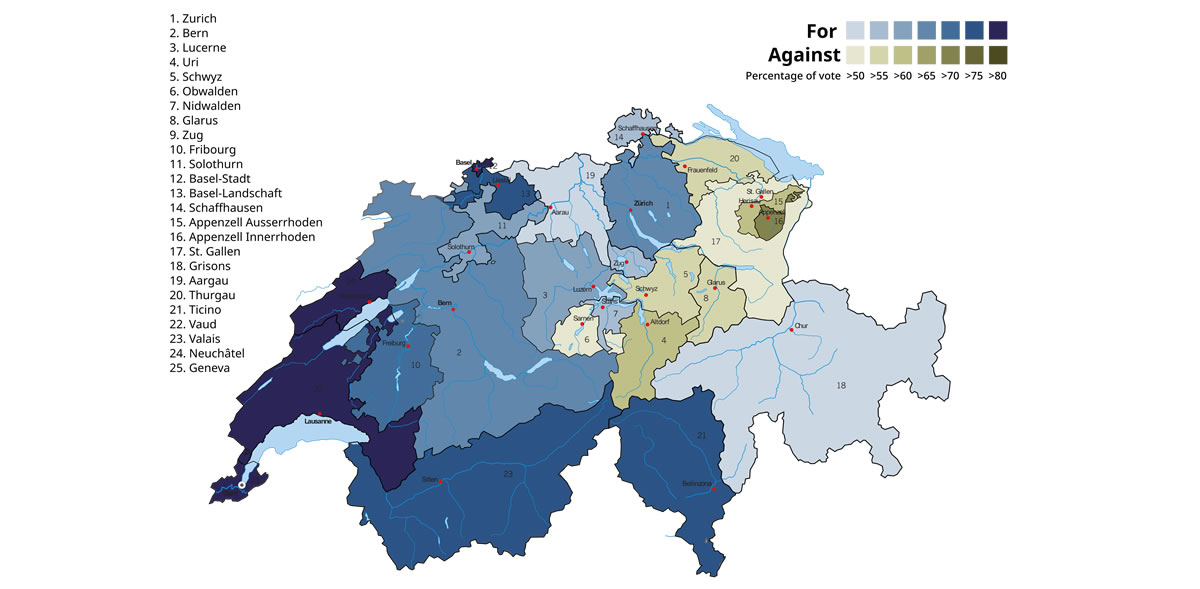
Results of the 1971 Swiss referendum on women’s suffrage by canton
Women’s Right to Vote in Switzerland
Women’s Day Switzerland / February 7, (1971)
When did women get the right to vote in Switzerland?
Switzerland, often celebrated for its democratic traditions, was paradoxically one of the last European countries to grant women the right to vote. The exact first date of women’s suffrage in Switzerland at the federal level was February 7, 1971, following a national referendum where 65.7% of Swiss men voted in favor of women’s suffrage. This milestone came remarkably late—over 50 years after many European neighbors and 123 years after Switzerland’s 1848 constitution established universal male suffrage.
The Long Struggle Begins
The Swiss women’s suffrage movement began in earnest during the late 19th century. In 1868, Marie Goegg-Pouchoulin founded the Association Internationale des Femmes, the first women’s rights organization in Switzerland. By the early 20th century, the Swiss Association for Women’s Suffrage was formed in 1909, uniting local suffrage societies across the country.
Despite organized advocacy, progress was excruciatingly slow. The Swiss political system, which required constitutional changes to be approved by popular referendum among male voters, created a significant obstacle for women seeking the vote.
Early Defeats and Persistent Activism
Several early attempts to secure voting rights met with failure:
- In 1929, a petition with 250,000 signatures demanding women’s suffrage was presented to the federal government but was ultimately ignored.
- In 1959, the first national referendum on women’s suffrage was decisively rejected, with 66.9% of men voting against it.
While the 1959 referendum represented a devastating setback at the federal level, it marked a breakthrough in the French-speaking canton of Vaud, which became the first canton to grant women voting rights at the cantonal level. Geneva, Neuchâtel, and Basel-City soon followed.
Key Figures in the Swiss Suffrage Movement
Emilie Kempin-Spyri (1853-1901)
Switzerland’s first female lawyer, Kempin-Spyri fought against legal discrimination. Despite her qualifications, she was denied the right to practice law because of her gender. Her famous argument that the term “Swiss citizens” in the constitution should include women laid important groundwork for later legal battles.
Marie Goegg-Pouchoulin (1826-1899)
A pioneer in Swiss feminism, she founded the first women’s rights organization in Switzerland and advocated strongly for educational and political equality.
Émilie Gourd (1879-1946)
Editor of the feminist journal “Le Mouvement Féministe” for over 30 years, Gourd devoted her life to the suffrage cause and helped coordinate activism across linguistic regions of Switzerland.
Marthe Gosteli (1917-2017)
A key figure in the final push for suffrage, Gosteli led the Swiss Association for Women’s Suffrage during the crucial period leading up to the successful 1971 referendum. She later established the Women’s History Archive to preserve the history of the Swiss women’s movement.
The Path to Victory
Several factors converged to finally make women’s suffrage possible in 1971:
- International pressure increased as Switzerland remained an outlier among democratic nations.
- In 1968, Switzerland signed the European Convention on Human Rights with a reservation regarding women’s political rights, highlighting the contradiction in Swiss democracy.
- A second national referendum in 1971 finally succeeded, granting women the right to vote in federal elections and stand for political office.
The Last Holdout: Appenzell Innerrhoden
Remarkably, the story of women’s suffrage in Switzerland did not end in 1971. While federal voting rights were established, some cantons still denied women local voting rights. The last holdout was the canton of Appenzell Innerrhoden, which only granted women the right to vote in cantonal affairs in 1991—and only after being forced to do so by a federal court decision.
Swiss Women in Politics After 1971
Following the achievement of suffrage, women’s political participation grew gradually:
- In October 1971, the first federal election with female participation resulted in 11 women elected to the National Council.
- Elisabeth Kopp became the first female member of the Federal Council (executive branch) in 1984.
- Ruth Dreifuss became Switzerland’s first female President in 1999.
- In 2010, women briefly held a majority in the Federal Council.
Legacy and Reflection
The extraordinarily late arrival of women’s suffrage in Switzerland raises important questions about direct democracy. While the Swiss system is often praised for giving citizens direct input into governance, the women’s suffrage movement demonstrates that majority rule can sometimes impede progress toward equal rights when the majority is not directly affected by the inequality.
Today, Swiss democracy includes both women and men, but the memory of this belated inclusion serves as a reminder that democracy remains a work in progress. The women who persisted through decades of setbacks to achieve voting rights demonstrated remarkable resilience and commitment to democratic principles—even when those principles were not extended to them.
The story of women’s suffrage in Switzerland stands as a testament to the importance of persistence in the face of entrenched resistance and the ongoing work required to create truly inclusive democratic systems.
The Federal Assembly — The Swiss Parliament
Women’s suffrage in Switzerland: 100 years of struggle
On 7 February 1971, 53 years after Germany, 52 after Austria, 27 after France and 26 after Italy, Swiss women were granted the right to vote and stand for election. Women’s associations in Switzerland had had to pressure the Federal Council and work tirelessly to obtain a majority vote among the People and the cantons.
THE FIRST DEMANDS
In 1868, the women of Zurich demanded the right to vote when the cantonal constitution was revised – without success. In 1893, the Swiss Federation of Women Workers officially called for women to have the right to vote and stand for election. The Socialist Party (SP) was the first party to support the cause of women, starting in 1904. In 1909, a number of associations for women’s suffrage came together to form the Swiss Association for Women’s Suffrage (ASSF).
In 1918, two motions demanding women’s suffrage were submitted to the National Council. They were forwarded to the Federal Council, which left them, ignored, in a drawer.
> parlament.ch/political-women/conquest-of-equal-rights/women-suffrage

